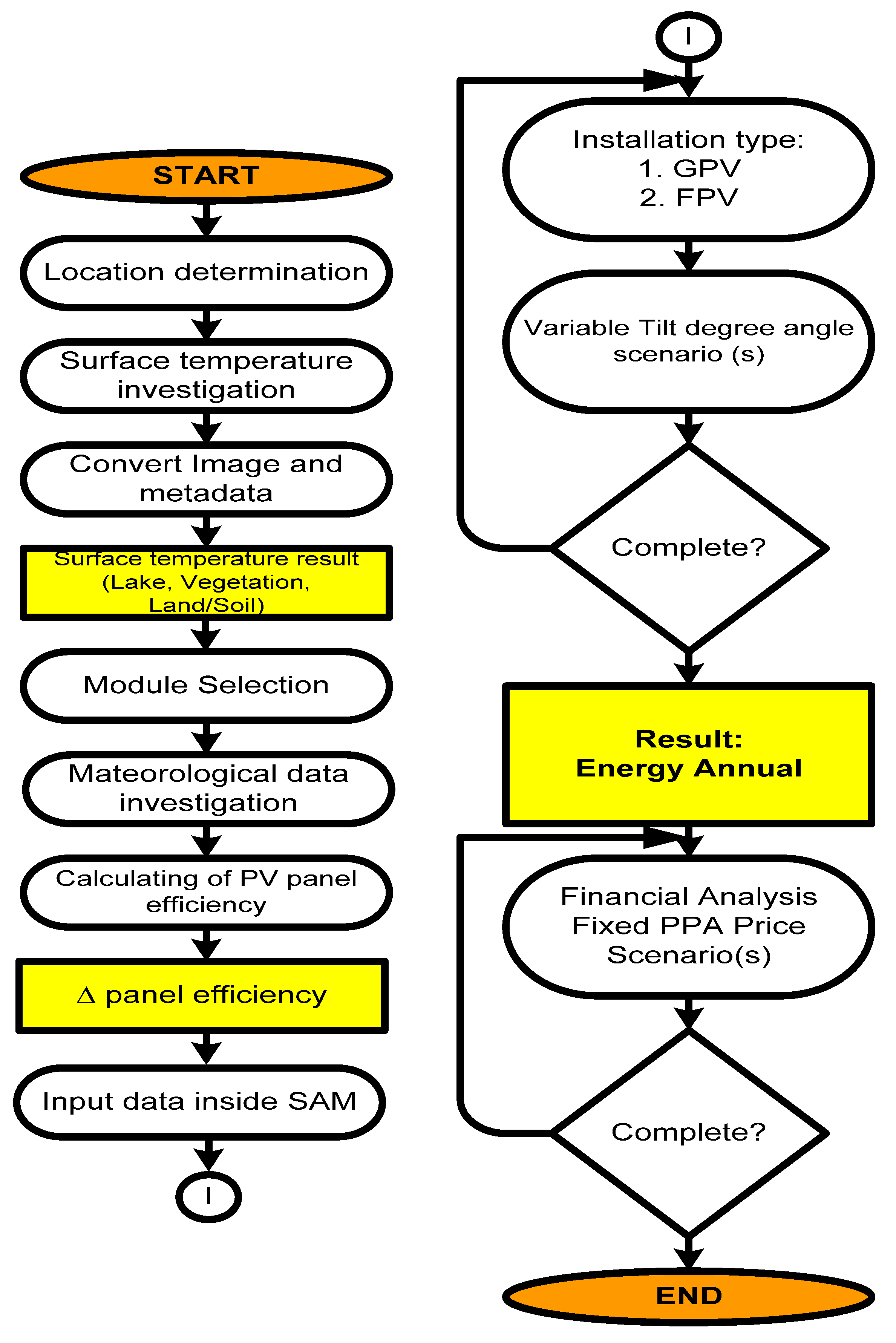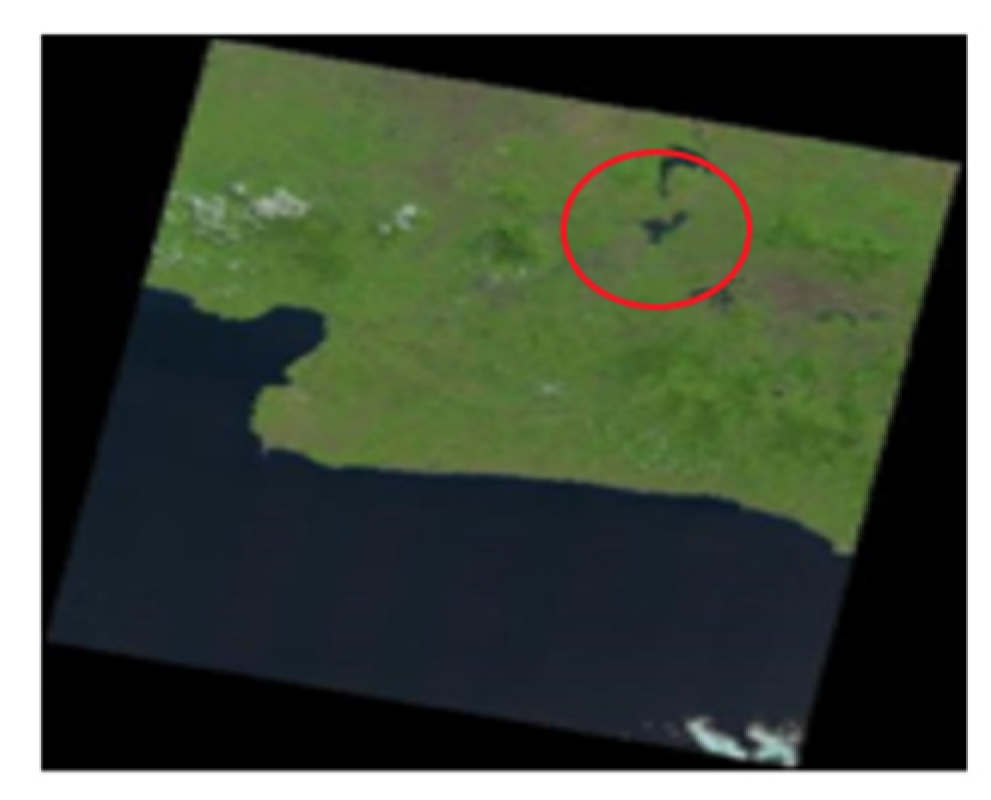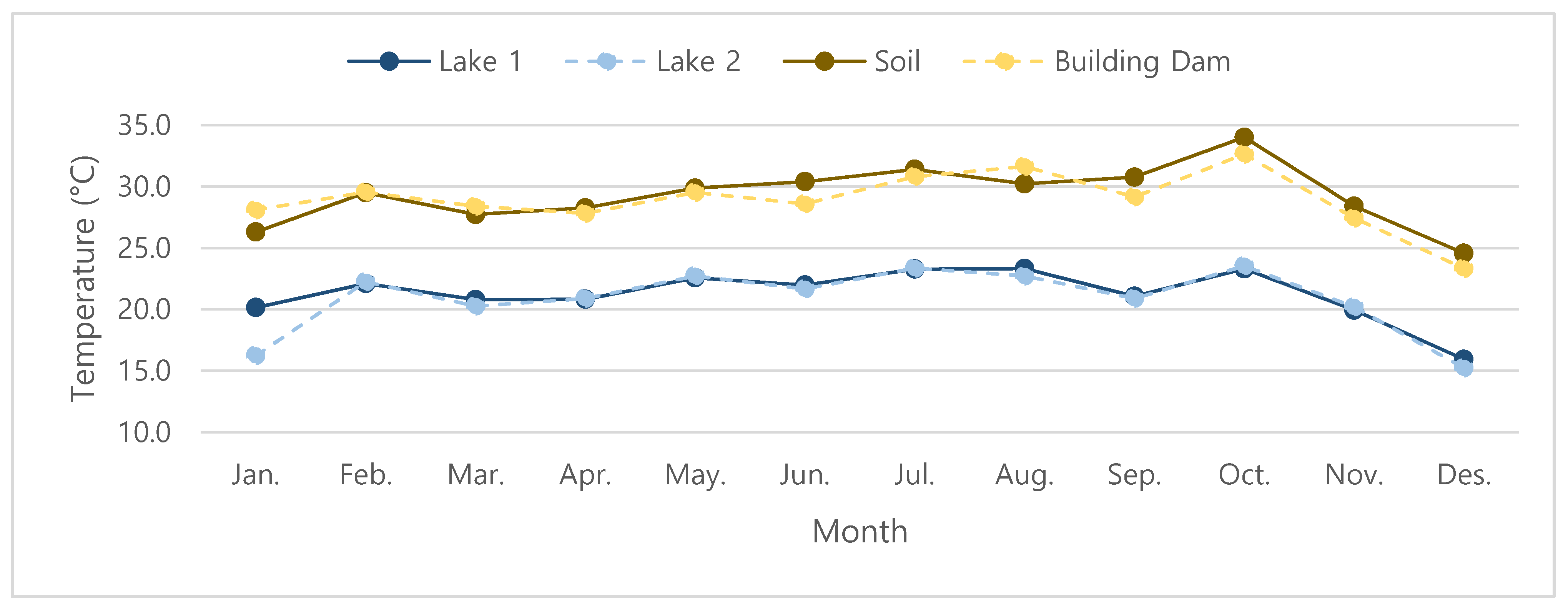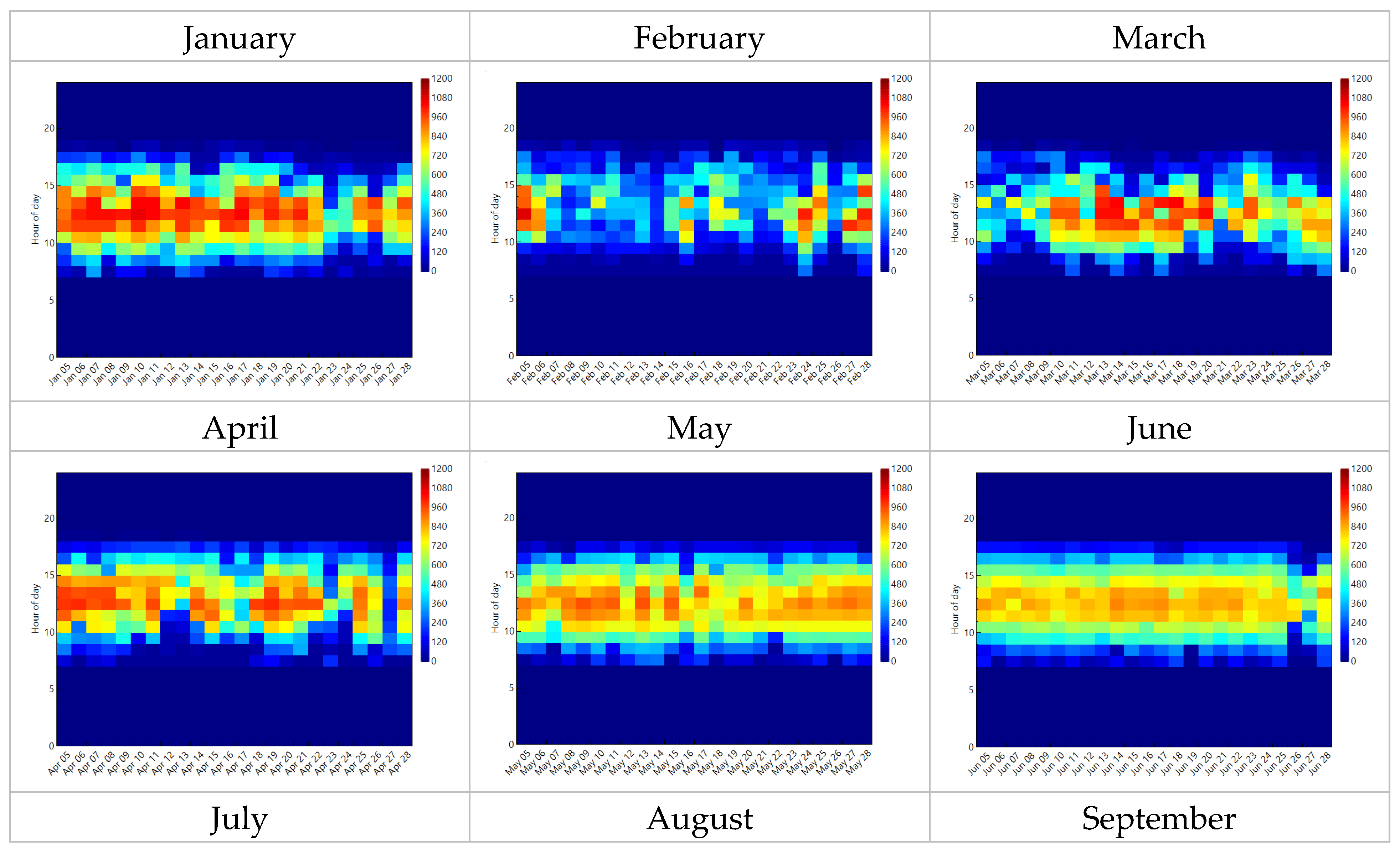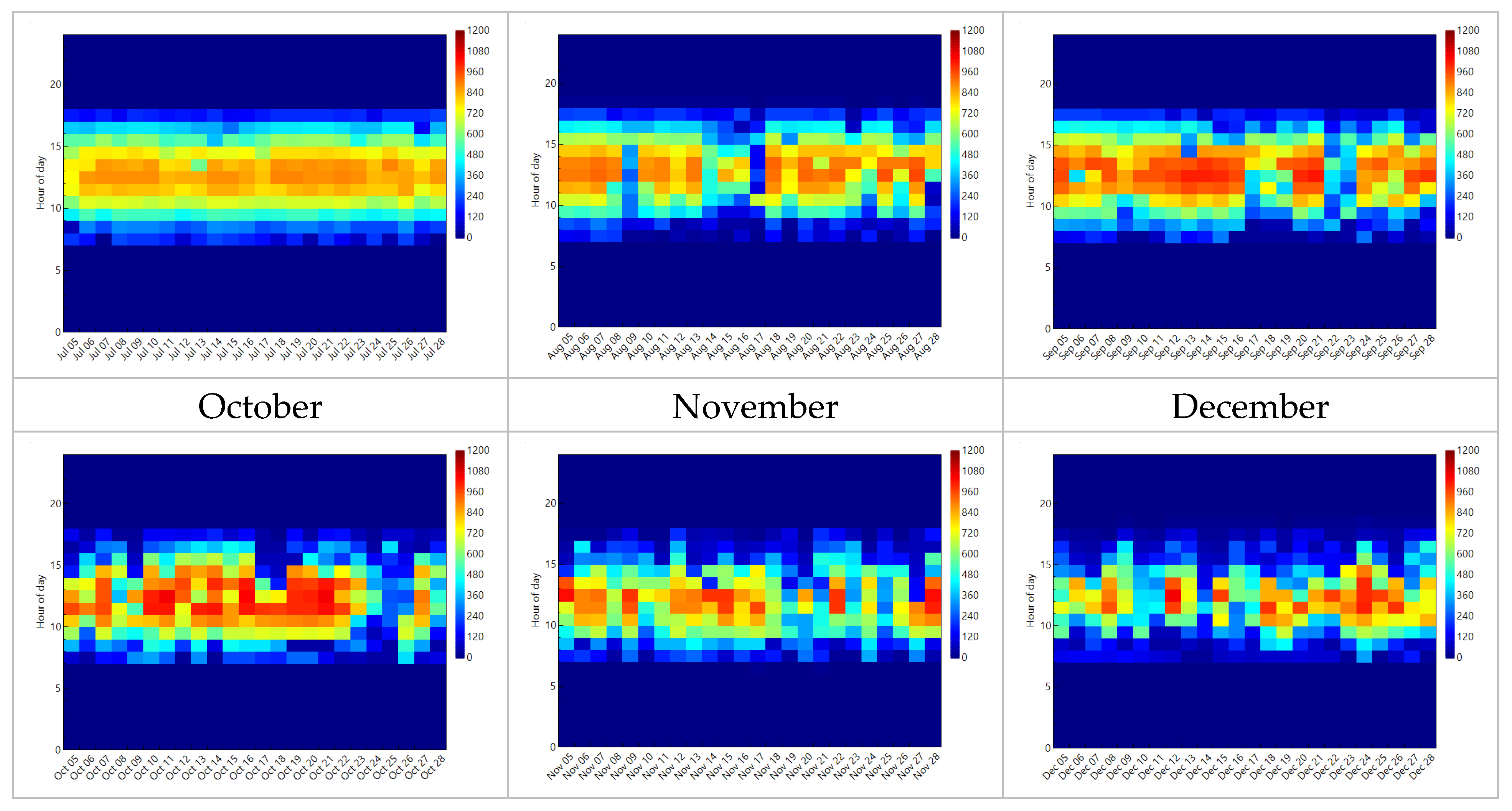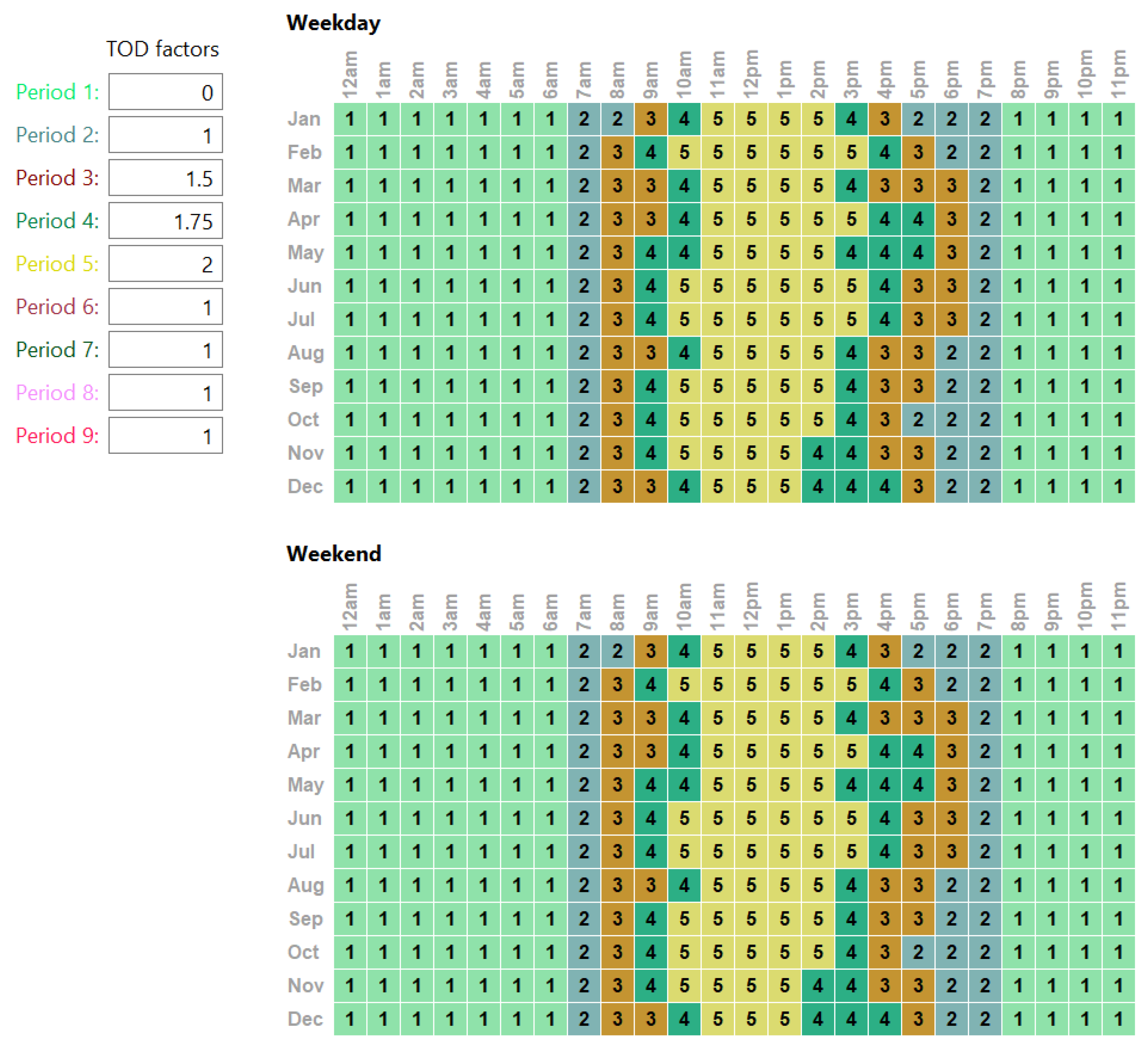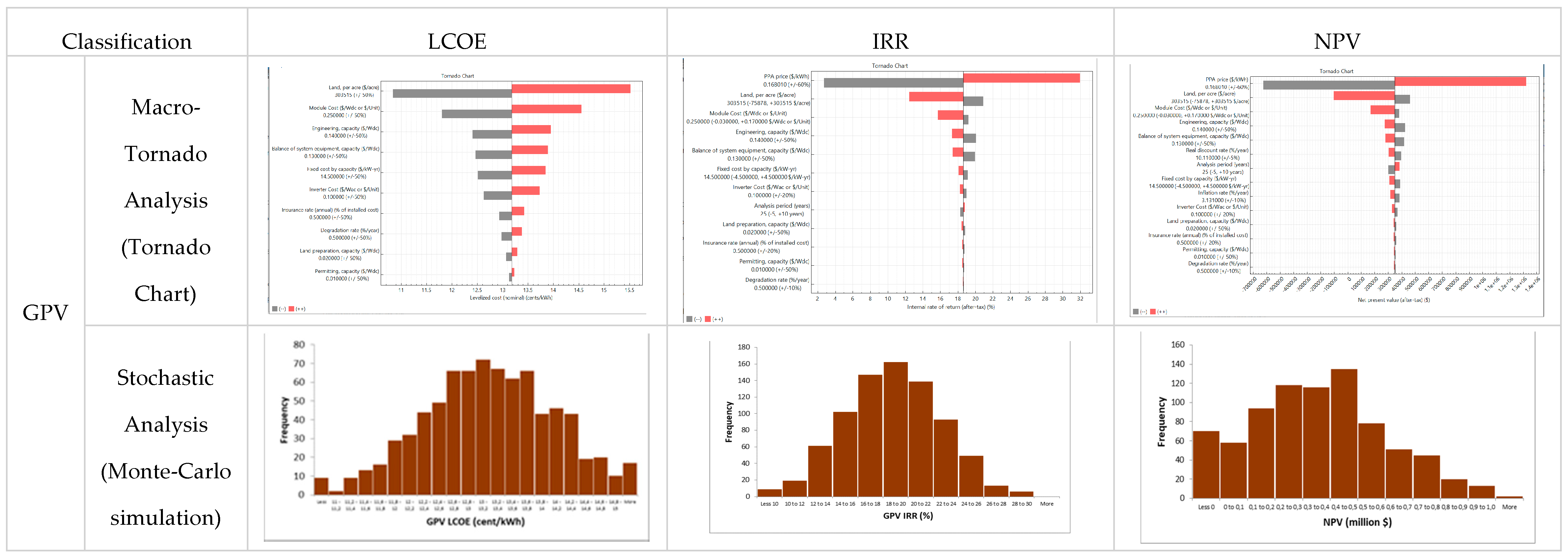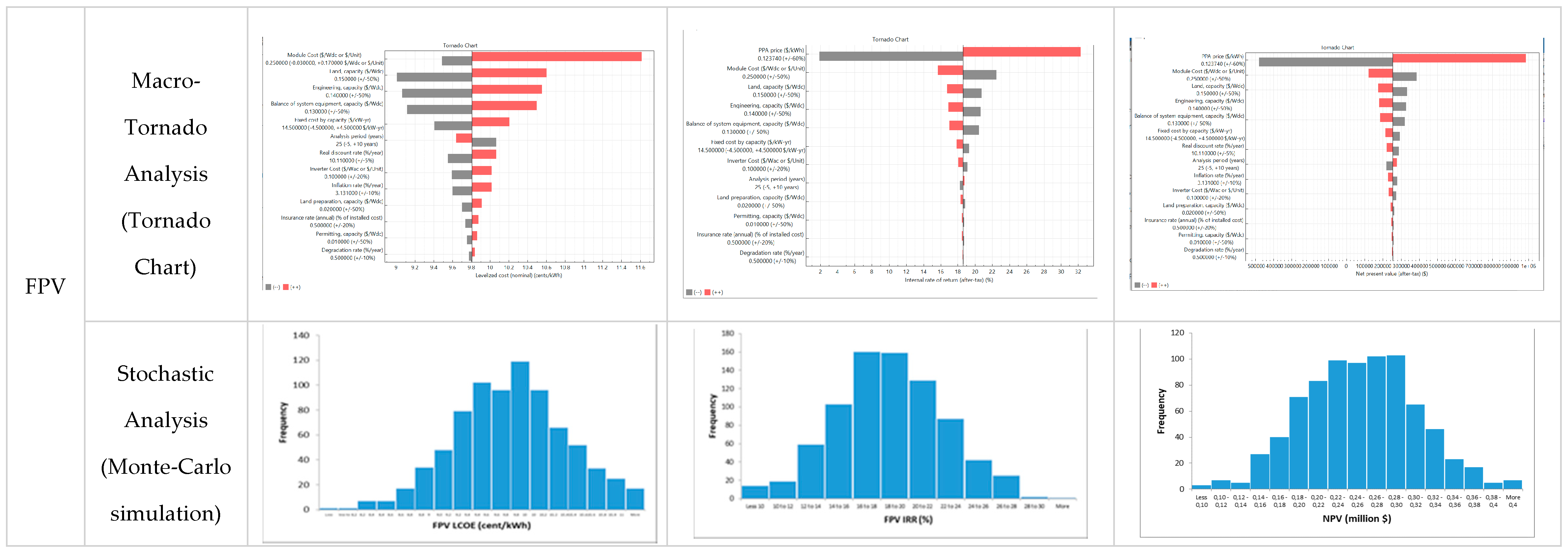1. Introduction
Consumption of energy is related to human welfare in life. Nowadays, the welfare of the world population is facing constraints of climate change that occur on earth after the period of industrialization. Energy consumption and production activities are responsible for two-thirds of greenhouse gasses (GHG) emissions. Almost 80% of the total energy sources are currently from fossil fuels [
1]. The electric power generation sector plays a significant role in total world energy consumption, where almost 70% usage of primary energy goes into electric power supply generation.
With a surface area of more than 1,900,000 km
2 and abundant natural resources, Indonesia has a high potential for renewable energy. The Indonesian state-owned electric company, PT Perusahaan Listrik Negara (PT PLN), from Indonesia national energy general plan [
2] estimates that a total potential capacity of 442.9 GW of electric power could be generated from renewable energy sources. A report from the national energy general plan explains that the average solar PV potential in Indonesia is 4.80 kWh/m
2/day.
The innovation of existing technology, especially electric energy supply, can contribute a significant role in developing an environmental-friendly electric energy supply [
3]. A new and renewable energy (NRE) technology and paradigm could constitute a solution to the problem of world dependence on fossil fuel-based energy. Technological innovation has made solar photovoltaic (PV) systems, wind energy systems, energy storage, and electric vehicles mature, commercially competitive, and well-developed [
1]. Solar PV global increasing capacity in 2017 was approximately 402 GW [
4]. Simultaneous to the increase in international awareness of solar PV beneficiaries, world-wide experts have predicted that the solar PV market will keep developing in the near future. Solar PV market penetration is also expected to create a positive collateral effect on the labor sector regarding work opportunity and availability [
5].
Nonetheless, technology is facing several significant challenges, such as intermittent limitations, low efficiency, land use, and tariff policy. Nowadays, the most popular installation type of solar PV is a ground-based installation type, which generally faces land price constraints because of the usage of land, which is a premium commodity. It is also well known that solar PV energy production has a strong correlation with operating panel temperature to determine solar PV panel efficiency.
In order to address land-use constraints, methods of solar PV installation have also evolved and now include rooftop, canal top, offshore, and floating (FPV) installations. FPV was first introduced in Aichi, Japan, 2007, and became prominent with its installation in Napa Valley, USA 2008 [
6]. Its total world capacity in 2013 was around 1.1 8MW and this was increased to 98.6 MW in 2017 [
7]. FPV has also become a solution for unused vast water surface areas such as lakes, dams, and water irrigation ponds to be recreated as economically and environmentally attractive projects in NRE production. Therefore, FPV is a suitable solution for a country which has a lot of hydropower plants with dams and open water areas. Even though FPV has been in use since 2007, there is no specific software to date that will allow us to include the cooling effect in its energy production measurement.
The economic parameter of an NRE is generally examined through the cost of electricity generation price. Utilization of NRE solar PV is also supported by market price reduction of the technology. At the end of 2018, with various types of commercial solar PV product, solar panel installation cost in the range of between
$0.215 and
$0.419/Watt [
8]. Therefore, electricity generated from that PV will have better competitiveness than fossil fuel-based electricity. The cost of generation also becomes one of the significant parameters to encourage investor attractiveness in the NRE sector. According to Indonesia’s state-owned electric company PT PLN’s statistical report [
9], in 2018, the estimation cost of NRE in Indonesia was still very high (around 54.8 cents/kWh) compared to a traditional steam power plant (5.93 cents/kWh).
The author realizes that predicting the energy produced by FPV is a challenge for many researchers. Therefore, in this article, the author designs a system to develop a combination of remote sensing methods and a process of calculating the efficiency of FPV, then completes this assessment with economic analysis. In particular, this study is the first trial to measure the location temperature from the remote sensing through emissivity and apply it to the FPV system performance. Therefore, the authors hope that the methodology and tools in this paper can be helpful to future FPV performance research.
2. Literature Review
According to Thi, 2017 [
10] and Sahu, Yadav et al. 2016 [
11], typical well known solar PV installations are ground-mounted, rooftop, canal top, offshore, and floating systems. The primary motivation of using floating solar PV (FPV) was related to premium land cost, utilization of open water area, and energy efficiency. The impact of the temperature rise of the PV module is one of the reasons for energy efficiency reduction from ground solar PV installation. Solar PV installation above water bodies will partly solve the mentioned deficiencies. This installation method also will prevent water evaporation, and with cooler temperatures beneath the solar panel, panel temperature will reduce, increasing energy production [
12]. Several cooling methods, including evaporative cooling, for the solar PV module, were proposed and investigated by Kalaiselvan, Karthikeyan et al. 2018 [
13], Rishi, Balachandran et al. 2018 [
14], Peng, Herfatmanesh et al. 2017 [
15], and Siecker, Kusakana et al. 2017 [
16].
FPV was shown to have a better environmental impact within construction, operation, and end-of-life period compared to GPV [
17]. Blocked sunlight due to FPV installation above the water reservoir and beneath the panel was considered to stop uncontrolled algae bloom growth and reduce the water reservoir evaporation process. FPV also only requires a smaller ground area compared to GPV for laydown and connecting processes. The previous floating installation resulted in solar PV efficiency increasing with various values compared to the ground installation of solar PV systems. In late 2018, Hydrelio© floater technology was one example of a type of floater that was available for FPV installation. Hydrelio© is a floater product from French company Ciel and Terre (Sainghin-en-Mélantois, France) which dominates around 75% of the Japanese market, which is the location of the most significant installations of the world’s FPV [
7].
Many studies have measured FPV efficiency in comparison to GPV (
Table 1).
The results showed that FPV efficiency is significantly superior to that of GPV. Kamuyu, Lim, et al. 2018 [
27] performed a study on a 500 kW installation at Hapcheon Dam, a water reservoir located in Hapcheon-Gun, South Korea. They were able to calculate the FPV module temperature as a function of wind speed, irradiation, ambient temperature, and water temperature before comparison with real measurements. The result shows that ambient temperature is one of the critical factors in determining FPV panel temperature, in addition to a method to calculate direct in-situ measurement or data access is through the national aeronautics and space administration (NASA) software named “NASA power” online application. Remote sensing results of lake surfaces’ water temperatures have generally been monitored to check global environmental change [
28] as well as limnetic contribution to the global carbon cycle [
29].
The satellites employed for water surface temperature monitoring include the advanced very high-resolution radiometer (AVHRR) as well as the along track scanning (ATSR) [
28,
30], moderate resolution imaging spectroradiometer (MODIS) [
31] and landsat satellite [
32]. The Landsat program was initiated in 1965 by the US government to gather facts about natural resources of the earth, and the government launched the first Landsat satellite in 1972. Currently, Landsat 7 and the most recent Landsat 8 are operating after being launched in 1999 and 2013, respectively [
33]. Landsat satellites provide the longest record of space-based land surface observations [
34]. Compared to the previously launched Landsat 7, Landsat 8 has a narrower spectral band, improved calibration and signal to noise characteristics, higher 12 bit radiometric resolutions, and more precise geometry [
35]. In this study, the authors also use remote sensing satellite imaginary methods to obtain water surface temperature.
For study purposes, the authors simulate a fixed type model of the FPV system with a capacity of 1 MW similar to that installed and operating at Cirata Dam, West Java province, Indonesia. The design of 1 MW FPV adopts the mathematical equation from Pašalić, Akšamović et al. 2018 [
36] which is planned at Jablanica Lake, Bosnia and Herzegovina and Song and Choi, 2016 [
37] at Ssangyong Open pit limestone, Korea. Several popular software packages such as RETScreen (Government of Canada), PVGIS (European Union/EU science hub, European Comission), PVWatts (The national renewable energy laboratoty/NREL, Washington, D.C., USA), System Advisor Model/SAM (NREL, Washington, D.C., USA), Homer can deliver a tool to calculate energy production of the NRE project [
38] while Psomopoulos, Ioannidis et al. 2015 [
39] and Blair, Dobos et al. 2014 [
40] compared and briefly reviewed the NRE software systems.
SAM is free software developed by NREL Lab for predicting the performance of renewable energy systems and analyzing the financial feasibility of a project. SAM is a techno-economic computer model that supports people who interest in the NRE industry. SAM is suitable for simulating NRE on-grid performance systems with the financial model of the NRE project. SAM’s advantages are the availability of simulations in the analysis section, which provide parametric, sensitivity, statistical, and probability results as an extension of analysis [
40].
Economic analysis composes a variety of evaluation methods such as the levelized cost of energy (LCOE), net present value (NPV), internal rate of return (IRR) and power purchase agreement (PPA). LCOE is a parameter that allows for the comparison of the alternative technologies within different scales of operation, different investment, and operating periods. LCOE also could be used to compare the cost of energy generated by renewable resources with fossil fuel-based power plants. PPA of electricity is a contract between two parties, commonly done by electricity sellers and electricity undertakers. The IRR of a project is the discount rate (nominal value according to SAM) that corresponds to zero NPV for the PPA financial models [
41]. IRR of an investment that has a series of future cash flows is a rate that sets the NPV of the cash flows equal to zero. IRR analysis is commonly used for either acceptation or rejection decisions, allowing a quick comparison with a minimum acceptable rate of return.
5. Conclusions and Discussion
Through remote sensing methodology, the authors found that water temperature in the area of interest, Lake 1 and Lake 2 at the Cirata dam area, has a higher cooling temperature value compared to ground temperature of the Soil and Dam. There is approximately an 8 °C consistent annual temperature difference among water and ground surface temperature in the area of interest. The highest average temperature difference among water-based and ground-based areas of interest is 15 °C in early October, while the lowest difference is 3.8 °C in November and December. From the calculation, the authors estimate that FPV has a lower operating panel temperature, and generates higher efficiency compared to GPV. The authors calculate that FPV installation on location Lake 1 has 0.11% higher efficiency compared to ground solar PV.
Regarding system design, the required area to create 1 MW of solar PV system is approximately 1.527 acres. According to financial performance calculations, and considering the MoEMR regulation No 50 of 2017, and its amendment by regulation No 53 of 2018, the NRE tariff buy rate based on BCoG and its province show that the solar PV project in West Java province is economically unfeasible. The tariff is too low to attract attention from private investors to invest in solar PV projects. Financial parametric results show a negative NPV either for FPV or GPV projects.
The authors conclude that it requires a tariff of 9.90 cents/kWh for FPV and 13.4 cents/kWh for GPV to have a positive NPF in West Java province. The difference among those technologies is about 3.5 cents/kWh. If the difference is then applied to the annual energy yield that is produced from 1 MW of installation capacity, it estimates around $46,260 (647 million rupiahs) of savings, which can be obtainable from FPV utilization. Considering this benefit from FPV, a supported and clear regulation policy of FPV utilization in Indonesia must be put in place.
The suggestion of a more economically feasible solution on existing tariffs is tariff adjustment. The government can carry out this approach by raising tariffs within the range of BCoG and implementation of time on delivery (ToD) scheme factors. As done in analysis through using the ToD factor considering heat map irradiation, it is possible to achieve positive NPV by creating a unique ToD scheme. ToD scheme can become an active policy to achieve maximum cost by considering of the system itself. The proposed system in this study does not apply the energy storage system to release energy at peak hours, only the application of the ToD scheme in the study.
Financial analysis with stochastic uncertain values on the input parameter shows that FPV is a more promising and interesting investment project than GPV. With an existing parameter, the LCOE value of FPV was estimated at within 9.2 to 10.2 cents/kWh while GPV was estimated to be within 12.6 to 13.8 cents/kWh. The IRR stochastic result showed that a value for FPV and GPV of more than 14% are both associated with possible increases of more than 88%. Positive NPV for the FPV installation has a better probability value with 99.6% while GPV is in the 91.2% range possibility. Considering the performance and financial results of both technologies, this factor will draw attention from both the government and investor side to develop FPV. The authors consider that the limitations regarding this paper are uncertainty values. The first of these is in determining an exact point for the location to increase the accuracy of temperature measurement. The authors tried to mitigate this with detailed and thorough reading. The second is the assumption values on a couple of cost parameters. The authors tried to apply sensitivity and stochastic analysis to fluctuating cost and price in order to represent the most accurate approach. Based on the results, the authors can conclude that FPV offers several advantages to mitigate the challenges in the deployment of solar PV. Therefore, the authors suggest a better and clear policy regarding the utilization of water reservoirs as a location for FPV installation as one of the leading solutions for energy transition.
